ONLINE NEWS: USM SEES HUGE POTENTIAL IN DEVELOPING MALAYSIA'S SPACE TECH ECOSYSTEM
The Sundaily
USM sees huge potential in developing Malaysia's space tech ecosystem
Monday, 26 June 2023

GEORGE TOWN: Universiti Sains Malaysia (USM), scheduled to launch its maiden satellite to space from Russia tomorrow, sees huge potential in developing the nation’s space technology ecosystem with the combined efforts of the academia, industry players and regulators.
Dean of USM’s School of Aerospace Engineering Prof Dr Farzad Ismail said the university signed a long-term agreement with a local space technology company, Angkasa-X Innovation Sdn Bhd, to develop and launch at least 400 low-earth-orbit (LEO) satellites.
“The function of these satellites is mainly to deliver better Internet connectivity, especially in rural areas that can benefit the students there. Considering that laying out fibre optics is expensive, using satellites is the only feasible way which goes well with USM because we are striving to help the bottom billion and change their socioeconomic well-being.
“We at USM have the skills and knowledge in satellite technology but developing this technology is capital intensive. We were stuck at a low level for a while until Angkasa-X came into the picture and they were ready to pump in the money,“ he told Bernama.
Under their agreement, Angkasa-X will invest RM30 million to set up a space technology station at USM’s engineering campus in Nibong Tebal which is expected to be operational in three months and be able to receive signals from satellites in space.
CREATE FUTURE SATELLITE ENGINEERS
Farzad said USM, on the other hand, will actively focus on human capital development specifically to produce satellite engineers by running a programme in this regard, starting January next year.
“With the financial muscle coming from Angkasa-X, we have one less thing to worry about and can instead focus on creating future satellite engineers which is equally important because regardless of how good the technology is, it just will not work without human capital.
“Currently, our faculty receives about 1,000 registrations per intake but our space is still limited due to the size of our facilities, therefore we are only able to accept 60 to 70 students per intake,“ he said.
He said its venture with Angkasa-X will also help in terms of employment opportunities for its students once they graduate given that there are not that many opportunities in this field in Malaysia currently.
Dr Siti Harwani Md Yusof, a senior lecturer at USM, said although these homegrown satellites could not yet compete technology-wise with those that have been in the game longer, USM could play around with the cost given that they are able to source their supplies locally in Penang, which is a global hub for semiconductors and electronics.
“With funding from Angkasa-X, we do have plans to undertake research and development (R&D) to enhance our technology, however, we can play around with the cost to appeal to potential customers in the Southeast Asian region for short term.
“Considering that we manufacture the satellites locally with homegrown engineers, we can actually offer these satellites at a lower cost compared to companies in Europe, the United States and Japan. When investments and demand start rolling in, we can improve our R&D. This is our plan to boost the industry,“ she said.
VAST OPPORTUNITIES FOR INDUSTRIES
She said Angkasa-X’s A-SEANSAT-PG1 satellite that will be launched from Russia tomorrow will not be its last satellite launch this year as USM, through SpaceIn Sdn Bhd – a spin-off company of the university – plans to launch a pocket cube satellite in October using SpaceX’s launcher in California in the United States.
Siti Harwani said pocket cube satellites are small, weighing less than one kilogramme each, and their mission is simple, namely to store data and forward them to the ground station.
Despite being small and simple, the pocket cube satellites are beneficial for industries such as those involved in agriculture, oil and gas (O&G) and energy.
“The satellite will orbit the earth, passing around sensors in agricultural areas, collecting data and eventually downloading that data to our ground station here in USM. Customers in the agriculture sector can get data such as carbon footprint, soil moisture level and fertility of the ground area.
“Meanwhile O&G companies can use this (satellite) by putting the sensors in their oil rigs in the middle of the ocean to monitor the temperature or anything they need. Satellite services can be useful because Internet connectivity can be an issue in these locations,” she said.
She added that energy companies that operate power plants, solar farms or hydroelectric power stations in remote areas can also use pocket cube satellites to monitor their plants without actually deploying manpower to the area.
MALAYSIA’S OWN ROCKET LAUNCHER?
While USM has the capability to produce its own satellites, the latter has to be launched into space from rocket launchers in the United States or Russia. Farzad, however, said it is planning to build its own rocket launcher eventually after Malaysia strengthens its space technology ecosystem.
He said USM is also working with Angkasa-X as well as their Russian counterpart SPUTNIX on technology and knowledge transfer, among others.
Commenting on the timeline of this goal, Siti Harwani said it will probably take between 10 and 20 years for Malaysia to produce its rocket launcher given that it requires thorough research in terms of technology and location.
“Determining the location is a challenge because we must take into account various things such as people’s heritage and access to abundant fuel supply. Furthermore, a large area will be needed to accommodate the booster rocket when it returns to Earth,“ she added.-Bernama
- Created on .
- Hits: 401
